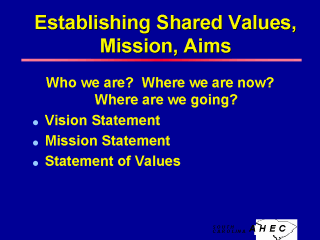| front |1 |2 |3 |4 |5 |6 |7 |8 |9 |10 |11 |12 |13 |14 |15 |16 |17 |18 |19 |20 |21 |22 |review |
 |
Who we are? Where we are now? Where are we going? The first step in strategic planning is to develop a realistic vision for the group. A vision statement defines the future position and value of a group. It should provide a picture that answers the question: “if someone from Mars visited the group, what would they see or sense?” The statement should be future-oriented but written in the present tense. The second step in strategic planning is developing a mission statement that communicates the overriding purpose of the group. The mission statement answers the questions “Who are we, whom do we serve, what products or services do we offer, and how do we make them available?” The mission statement deals with “hard” issues and is useful in unifying and mobilizing all stakeholders in the group. Some planning efforts also involve development of a Statement of Values for the group. Values are the bases upon which a group wants decisions to be made and actions to be taken. They deal with “softer” issues such as the reason for existence, unique or distinctive features, important philosophical and social issues, image, quality, standards, and stakeholder concerns. Culture and climate are also important considerations when defining values. The culture of a group includes traditions, ethics, and other standards, which influence the way in which decisions are made and value is assessed. The climate defines interpersonal and physical environments. |
| front |1 |2 |3 |4 |5 |6 |7 |8 |9 |10 |11 |12 |13 |14 |15 |16 |17 |18 |19 |20 |21 |22 |review |